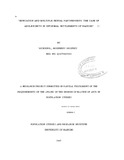| dc.description.abstract | HIVIAIDS prevalence in urban centres has been consistently reported as higher
than its prevalence in rural areas and Kenya as a whole. HIVIAIDS prevalence is higher
among adolescents than in the general population. Female adolescents are more affected
than their male counterparts suggesting correspondingly higher levels of risky sexual
behaviours such as multiple partners. Past studies on adolescence sexual behaviours
focused on poverty and substance use without accounting for the integrative dynamics of
education and sex that influence sexual behaviours and determine both reproductive and
sexual health outcomes. Education and having multiple partners among females remain
largely unexplored especially in informal settlements of Nairobi. Evidence points to low
school enrolment rates, early school dropouts, wide sex gaps in school enrolment, early
coital debut and sexual concurrency as the causes of poor sexual health outcomes.
This study uses data collected from a representative sample of female adolescents
-, in Nairobi's informal settlements to explore the relationship between education and
having multiple sexual partners. African Population and Health Research Centre
(APHRC) carried out the NCSS survey. The APHRC survey included an adolescence
schedule to generate information on adolescence sexual health and knowledge on
HIVIAIDS. This study focuses on 1,148 female adolescents in 12 - 24 years age bracket
who responded to a question on number of sexual partners in a twelve-month period.
The study incorporates individual level characteristics, knowledge of HIV/AIDS
and access to multimedia HIVIAIDS information in investigating influence of education
on the risk of having multiple sexual partners among female adolescents. Frequency
distributions and cross tabulations were employed to describe background characteristics
and associations. Multiple logistic regressions, however, was the main tool of analysis
and for assessing predictor variables and risk of having multiple sexual partners.
Findings indicate that approximately 35 percent of adolescent respondents had
multiple sexual partners. The logistic. regressions resul.t~ shew- that the risk of having
multiple sexual partners among adolescents with secondary education is 3.24 times
greater than adolescents with no education considering gross effects of education.
However, after controlling for demographic variables, secondary category is 1.33 times
more likely to have multiple sexual pat1ners than no education category. Adolescents
with higher education are 0.07 times less likely to have multiple sexual partners than
those with no education; and higher category is also statistically significant while after
controlling for economic factors adolescents with higher education are 0.04 times less
likely to have multiple sexual partners than adolescents with no education.
The risk of having multiple sexual partners among adolescents with higher
education remained low in all the models. However, inclusion of psychosocial and
multimedia access of HIV/AIDS information marginally shifts risk of having multiple
sexual partners upwards for all categories except higher education. Adolescents with
secondary education are 1.2 times more likely to have multiple sexual partners than
adolescents with no education after controlling for psychosocial factors. Overall, the
study results suggest that the odds of having multiple sexual partners varies among age
groups and marital status, which contribute to the effects of education on the risk of
having multiple sexual partners. The observed higher odds of having multiple sexual
partners in secondary category are attributed to unstable sexual unions while lower odds
of higher education attributed to stable sexual partners among older adolescents. | en |

